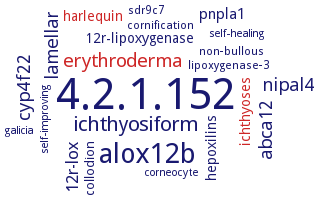4.2.1.152: hydroperoxy icosatetraenoate dehydratase
This is an abbreviated version!
For detailed information about hydroperoxy icosatetraenoate dehydratase, go to the full flat file.

Word Map on EC 4.2.1.152 
-
4.2.1.152
-
alox12b
-
ichthyosiform
-
erythroderma
-
lamellar
-
nipal4
-
abca12
-
cyp4f22
-
12r-lox
-
pnpla1
-
harlequin
-
12r-lipoxygenase
-
ichthyoses
-
hepoxilins
-
collodion
-
lipoxygenase-3
-
sdr9c7
-
cornification
-
non-bullous
-
galicia
-
self-healing
-
corneocyte
-
self-improving
- 4.2.1.152
- alox12b
-
ichthyosiform
- erythroderma
-
lamellar
-
nipal4
-
abca12
- cyp4f22
- 12r-lox
- pnpla1
- harlequin
- 12r-lipoxygenase
- ichthyoses
-
hepoxilins
-
collodion
- lipoxygenase-3
-
sdr9c7
-
cornification
-
non-bullous
-
galicia
-
self-healing
-
corneocyte
-
self-improving
Reaction
Synonyms
ALOXE3, eLOX-3, eLOX3, epidermal lipoxygenase-3, epidermal LOX type 3, epidermis-type lipoxygenase 3, hepoxilin synthase
ECTree
Advanced search results
General Information
General Information on EC 4.2.1.152 - hydroperoxy icosatetraenoate dehydratase
Please wait a moment until all data is loaded. This message will disappear when all data is loaded.
evolution
the lipoxygenase (LOX) family contains enzymes catalyzing dioxygenation or, for epidermis-type lipoxygenase 3 (eLOX-3), hydroperoxide isomerization of polyunsaturated fatty acids. Five LOX mRNAs are known to be expressed in human epidermal cells: eLOX-3, 12R-lipoxygenase (12RLOX), 12S-lipoxygenase (12S-LOX), 15-lipoxygenase 1 (15-LOX-1), and 15-lipoxygenase 2 (15-LOX-2), expression profiles, overview
malfunction
mutations in nine different genes are known to be responsible for ichthyoses. One of them is the lipoxygenase gene Aloxe3 encoding the epidermal lipoxygenase-3 (eLOX-3). eLOX-3-deficient mice decease rapidly after birth due to transepidermal water loss, short life-span of eLOX-3 null mice. For a prenatal gene therapy approach, intra-amniotic delivery of eLOX-3 to mice at gestational day 14.5, both via an adenoviral vector and as recombinant protein, is undertaken resulting in fetal growth restriction and intrauterine death. Periodic acid-Schiff staining and RT-PCR analysis of placentae from fetuses exposed to eLOX-3 indicate a lack of glycogen trophoblasts in the junctional zone, overview. Placenta-specific gene expression is altered. Thus, the observed prenatal toxicity of eLOX-3 can be due to a strong effect on placental development
physiological function
physiological function
the epidermal lipoxygenase-3 (eLOX-3) is involved in the conversion of fatty acids to specific epoxyalcohol derivatives such as ceramide precursors and hepoxilins and plays an important role in the generation of the permeability barrier of the skin, which protects against dehydration and physical injury. eLOX-3 appears to have some impact on the expression of genes that indirectly influence fetal development


 results (
results ( results (
results ( top
top






